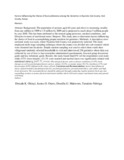Please use this identifier to cite or link to this item:
http://ir-library.mmust.ac.ke:8080/xmlui/handle/123456789/2017Full metadata record
| DC Field | Value | Language |
|---|---|---|
| dc.contributor.author | Okinyi, Dorcah K. | - |
| dc.contributor.author | Osero, Justus O. | - |
| dc.contributor.author | Makworo, Drusilla G. | - |
| dc.contributor.author | Ndwiga, Taratisio | - |
| dc.date.accessioned | 2022-01-10T12:39:28Z | - |
| dc.date.available | 2022-01-10T12:39:28Z | - |
| dc.date.issued | 2020-08-01 | - |
| dc.identifier.uri | https://www.iosrjournals.org/iosr-jnhs/papers/vol9-issue4/Series-7/G0904075056.pdf | - |
| dc.identifier.uri | http://ir-library.mmust.ac.ke:8080/xmlui/handle/123456789/2017 | - |
| dc.description.abstract | Background; The population of persons aged 60 years and above is increasing steadily from one million in 1989 to 1.9 million by 2009 and is projected to reach about 3 million people by year 2030. This has been attributed to the normal aging processes, medical conditions, and lifestyles in terms of nutritional status. Purpose: This study aims to determine factors influencing the choice of food in accomplishing proper nutrition for geriatrics. Methods; A descriptive cross sectional study was used, where Nyamira Sub County was purposively selected. The study employed multi-stage sampling technique where the county was divided into sub-counties which were clustered into locations. Simple random sampling was used to select three wards then villagesand randomly selected households to visit and interviewed 230 geriatrics where data was collected by use of face to face researcher administered questionnaire, focused group discussion guide and key informant guide. Results; the study found that(43% )of the respondents were male while (57% )were females. (51.3% were married and marital status was significantly related with nutritional status (χ 2=27.77, P<0.01). Physiological factors such as disease conditions (13.9%), body changes as well as psychological factors such as culture (12.2%), economic status (56.1%), loneliness (13%) and bereavement (4.8%) influenced the choice of food. Conclusion and Recommendation; factors that influenced choice of food included: physiological factors, psychological factors, personal preferences, and culture and high levels of poverty. The associated factors should be addressed through conducting regular medical check-ups and counselling sessions to ensure physical and mental stability which will lead to proper nutritional status and general well-being | en_US |
| dc.language.iso | en | en_US |
| dc.publisher | IOSR Journal of Nursing and Health Science (IOSR-JNHS) | en_US |
| dc.subject | Factors, Influencing, Choice, food, preference , Geriatrics | en_US |
| dc.title | Factors Influencing the Choice of food preference among the Geriatrics in Nyamira Sub-County, Kisii County, Kenya. | en_US |
| dc.type | Article | en_US |
| Appears in Collections: | Journal Articles | |
Files in This Item:
| File | Description | Size | Format | |
|---|---|---|---|---|
| Factors Influencing the Choice of food preference among the Geriatrics in Nyamira Sub.pdf | 300.33 kB | Adobe PDF |  View/Open |
Items in DSpace are protected by copyright, with all rights reserved, unless otherwise indicated.
